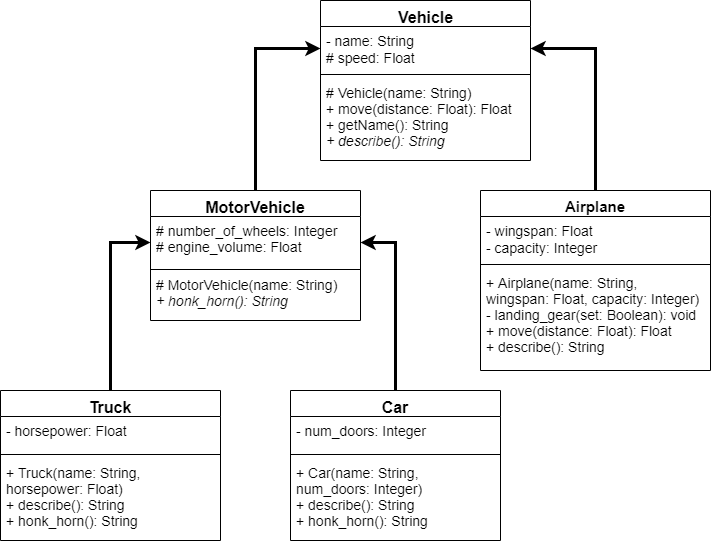Abstract Classes
Note: this video contains errors in the UML diagram, these errors have been fixed below.
Another major feature of class inheritance is the ability to define a method in a parent class, but not provide any code that implements that function. In effect, we are saying that all objects of that type must include that method, but it is up to the child classes to provide the code. These methods are called abstract methods, and the classes that contain them are abstract classes. Let’s look at how they work!
Abstract
In the UML diagram above, we see that the describe() method in the Vehicle class is printed in italics. That means that the method should be abstract, without any code provided. To do this in Java, we simply must use the abstract keyword on both the method and the class itself:
public abstract class Vehicle{
private String name;
protected double speed;
public String getName(){ return this.name; }
protected Vehicle(String name){
this.name = name;
this.speed = 1.0;
}
public double move(double distance){
System.out.println("Moving");
return distance / this.speed;
}
public abstract String describe();
}Notice that the keyword abstract goes after the security modifier, but before the class keyword on a class declaration and the return type on a method declaration.
In addition, since we have declared the method describe() to be abstract, we must place a semicolon after the method declaration, without any curly braces. This is because an abstract method cannot include any code.
Now, any class that inherits from the Vehicle class must provide an implementation for the describe() method. If it does not, that class must also be declared to be abstract. So, for example, in the UML diagram above, we see that the MotorVehicle class does not include an implementation for describe(), so we’ll also have to make it abstract.
We can also declare a class to be abstract without including any abstract methods. By doing so, it prevents the class from being instantiated directly. Instead, the class can only be inherited from, and those child classes can choose to be instantiated by omitting the abstract keyword.
Try It!
Let’s see if we can update the Vehicle and MotorVehicle classes to be abstract, with an abstract definition for the describe() and horn_honk() method as well.
